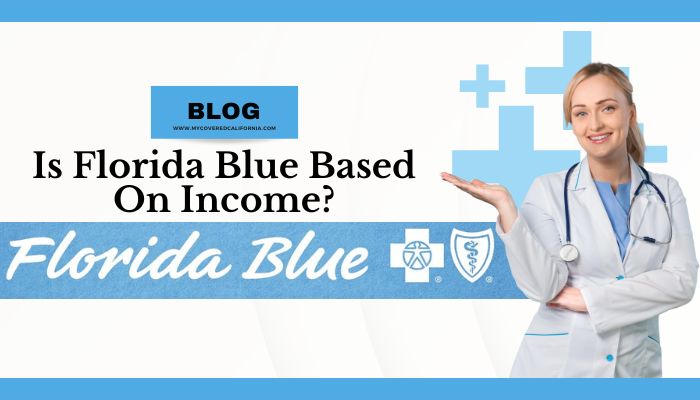Making informed decisions about your health insurance can feel overwhelming. This article delves into understanding Florida Blue, a leading healthcare provider in Florida, and how income can play a crucial role in navigating your health coverage options. Is Florida Blue Based On Income?

Is Florida Blue Based On Income?
- Florida Blue is a prominent health insurance provider in Florida, offering a diverse range of plans catering to individuals, families, and employers.
- They are part of the GuideWell family of companies, committed to improving the health and well-being of Floridians.
Understanding the Impact of Income on Health Insurance
- Income is a significant factor influencing your health insurance options. Understanding how income interacts with your health plan can empower you to make informed choices.
- This article explores Florida Blue’s plans and how income-based subsidies under the Affordable Care Act (ACA) can make health insurance more affordable for eligible individuals and families.
This concise table breaks down Florida Blue’s health insurance plans and the key factors influencing their costs. It provides a clear overview of plan types and the determinants of premium expenses, enhancing readability and understanding.
| Plan Types | Description |
|---|---|
| Individual and Family | Tailored for individuals and families seeking coverage independently of employer-sponsored plans. |
| Employer-Sponsored Plans | Available through workplaces, offering group health insurance options for employees. |
| Medicare Plans | Specifically designed for individuals aged 65 and over, or those with qualifying disabilities eligible for Medicare. |
| Factors Influencing Cost | Details |
|---|---|
| Age and Demographics | – Younger individuals typically have lower premiums. |
| – Factors like tobacco use can impact costs. | |
| Geographic Location | – Premiums vary based on location due to healthcare costs and provider availability. |
| Coverage Options and Types | – The chosen coverage level (e.g., bronze, silver, gold, platinum) and plan type (HMO, PPO) affect premiums. |
| – Opting for higher deductibles and copays lowers premiums but increases out-of-pocket costs when care is needed. |
Finding Relief: Income-Based Subsidies
- Income-based subsidies are financial assistance programs designed to make health insurance more affordable for individuals and families with lower incomes. These programs help bridge the gap between the actual cost of the plan and what you can afford to pay.
- The Affordable Care Act (ACA), also known as Obamacare, established two crucial subsidy programs:
- Premium Tax Credits (PTCs): These credits are applied directly to your monthly premiums, effectively lowering your out-of-pocket cost. The amount of PTC you receive depends on your income, family size, and the cost of the plan you choose.
- Cost-Sharing Reductions (CSRs): Also known as silver subsidies, CSRs help reduce your out-of-pocket costs for deductibles, copays, and coinsurance when you utilize covered services within your chosen plan.
Remember: Eligibility for income-based subsidies is determined by your household income and family size. You can use the Healthcare.gov marketplace to estimate your eligibility and potential subsidy amount.
Florida Blue Marketplace Plans: Understanding Coverage Options and Eligibility
Finding the right health insurance plan can feel like navigating a maze, especially when wading through unfamiliar terms and complex enrollment processes. This article delves into Florida Blue Marketplace plans: what they are, who qualifies, and how to navigate the enrollment process.
Here’s a breakdown of Florida Blue Marketplace plans:
- Individual coverage: Ideal for individuals seeking health insurance independently of an employer-sponsored plan.
- Family coverage: Extends coverage to spouses, dependent children, and, in some cases, other qualified dependents.
It’s important to note that marketplace plans are not the same as employer-sponsored plans. They cater specifically to individuals and families who don’t have access to health insurance through their workplace.
The Income Connection: Unveiling Eligibility for Premium Subsidies
One of the significant advantages of Marketplace plans is the potential for premium subsidies. These are financial assistance programs offered by the government to help eligible individuals and families afford their health insurance premiums. The key factor determining eligibility for these subsidies is household income.
- Subsidy eligibility: Your income, household size, and geographic location all play a role in determining whether you qualify for premium subsidies.
- Lower premiums: If you qualify for a subsidy, it will be applied directly to your monthly premium, potentially making your plan significantly more affordable.
Here’s a simplified illustration:
Imagine two individuals with similar health needs. One has a higher income and doesn’t qualify for a subsidy, while the other has a lower income and receives a subsidy. The individual with the higher income will likely pay a higher monthly premium compared to the one receiving the subsidy.
Navigating the Metal Tiers: Understanding the Cost Spectrum
Florida Blue Marketplace plans are categorized into metal tiers: Bronze, Silver, Gold, and Platinum. These tiers represent varying levels of costs and coverage:
- Bronze: Lowest monthly premiums, but with the highest deductibles and out-of-pocket costs. Ideal for individuals who are generally healthy and anticipate using their insurance less frequently.
- Silver: Moderate monthly premiums, with moderate deductibles and out-of-pocket costs. This is a good balance for those seeking a balance between affordability and coverage.
- Gold: Higher monthly premiums, but with lower deductibles and out-of-pocket costs. Suitable for individuals who anticipate needing more frequent medical care.
- Platinum: Highest monthly premiums, but with the lowest deductibles and out-of-pocket costs. Ideal for individuals who require comprehensive coverage and want to minimize upfront costs when seeking healthcare.
It’s crucial to remember: The optimal metal tier depends on your circumstances, risk tolerance, and anticipated healthcare needs. Carefully consider your budget and healthcare utilization patterns before choosing a tier.
Verifying Your Income: Ensuring Smooth Enrollment
Enrolling in a Florida Blue Marketplace plan requires income verification to determine your eligibility for premium subsidies. The Marketplace employs various methods to verify your income:
- Direct data transfer: The Marketplace retrieves your income information directly from the Social Security Administration (SSA) and the Internal Revenue Service (IRS) with your consent.
- Federal Poverty Level (FPL) calculator: You can use the Marketplace’s FPL calculator to estimate your eligibility based on household size and income.
- Manual verification: In some cases, you may need to submit documentation like tax returns or pay stubs to verify your income.
Here are some documents you might need for manual verification:
- Pay stubs
- W-2 forms
- Tax returns
- Social Security statements
Ensuring accurate income reporting is vital. Providing incorrect information can lead to delays in enrollment, potential repayment of received subsidies, and even tax penalties. If you’re unsure about your income or require assistance with the verification process, don’t hesitate to seek help from a certified enrollment agent or healthcare professional.
By understanding the intricacies of Florida Blue Marketplace plans, including eligibility for premium subsidies, metal tier options, and the income verification process, you can make informed decisions and navigate the enrollment process smoothly.
Remember, seeking professional guidance throughout the process can ensure you secure the most suitable and affordable coverage for your unique healthcare needs.
Addressing Criticisms: Separating Fact from Fiction
These concise counterpoints succinctly address the concerns related to sustainability, work disincentives, and administrative complexities of income-based healthcare programs.
| Concerns | Criticism | Counterpoint |
|---|---|---|
| Sustainability | Heavy reliance on income-based subsidies may be unsustainable with rising healthcare costs. | The economic benefits of a healthier population can outweigh the costs. Exploring alternative funding and cost-containment measures contributes to sustainability. |
| Work Disincentives | Subsidized healthcare may discourage full-time employment, impacting the workforce. | Overlooks complexities; healthcare access improves well-being and workforce participation. Program design can avoid disincentives by gradually reducing subsidies with increasing income. |
| Administrative Complexities | Implementing income-based programs can be administratively complex, raising efficiency concerns. | Acknowledges the need for streamlined processes. Technological advancements and evaluations enhance efficiency. Clear communication and outreach ensure participants understand eligibility and navigate effectively. |
Drawbacks and Limitations
Embarking on an understanding of income-based healthcare programs, we scrutinize a pivotal concern – program design variations. In the table below, we dissect the drawbacks stemming from disparate program structures and propose thoughtful solutions to foster consistency and empower individuals in making informed healthcare decisions.
| Drawbacks and Solutions | Program Design Variations |
|---|---|
| Drawback | Different income-based programs lead to confusion and inconsistency, potentially creating disparities. |
| Solution | Standardized program design across regions, considering healthcare cost variations, promotes consistency and equity. Clear information empowers informed healthcare choices. |
Our journey through the intricacies of program design variations concludes with a vision for standardized approaches. By advocating for uniformity while recognizing regional nuances, we strive to eliminate disparities, ensuring equitable access to coverage and facilitating informed healthcare choices for all.
Delving into the intricacies of income-based healthcare, we turn our attention to a critical challenge – the potential “cliff effect.”
The following table dissects the drawbacks associated with sudden subsidy cutoffs and offers solutions to facilitate a smoother transition, encouraging professional growth without compromising healthcare coverage.
| Potential “Cliff Effect” | Some programs abruptly cut subsidies at a certain income threshold, hindering upward mobility. |
|---|---|
| Solution | Implementing a gradual subsidy reduction with income increases provides a smoother transition, encouraging higher-paying jobs without jeopardizing coverage. Glide path mechanisms offer adjustment time. |
As we wrap up our examination of the potential “cliff effect,” our focus on gradual subsidy reduction aims to align incentives with upward mobility. The proposed glide path mechanisms provide a blueprint for a healthcare system that encourages financial progression without creating barriers to comprehensive coverage.
As we wrap up our examination of the potential “cliff effect,” our focus on gradual subsidy reduction aims to align incentives with upward mobility. The proposed glide path mechanisms provide a blueprint for a healthcare system that encourages financial progression without creating barriers to comprehensive coverage.
| Provider Participation | Not all providers participate due to lower reimbursement rates, limiting access, especially in rural areas. |
|---|---|
| Solution | Increase provider incentives through collaboration with agencies. Alternative payment models and community health center partnerships enhance access, particularly in underserved regions. |
In concluding our exploration of provider participation, our vision extends beyond reimbursement rates. By bolstering incentives, fostering collaborations, and embracing alternative models, we strive to create a network of providers that ensures comprehensive access to care, particularly benefiting communities in need.
Key Takeaways
Special Enrollment Periods (SEPs) allow plan changes outside Open Enrollment due to life events like job loss, marriage, or moving. Is Florida Blue Based On Income?
Income changes can trigger SEPs and impact your eligibility for premium subsidies and Medicaid. Consider plans with higher deductibles for lower premiums, but manage out-of-pocket costs proactively.
Prioritize lower deductibles for immediate financial security, explore co-pay/coinsurance reductions, and utilize cost-saving strategies like negotiating with providers. Utilize preventive care and explore medication assistance programs to manage healthcare costs effectively.
